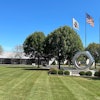Chris Kuehl, economic analyst for the Fabricators & Manufacturers Association, offers 10 predictions for 2011 that will impact both manufacturing and other sectors.
|
Chris Kuehl |
It will be a “mixed bag” for the manufacturing community as the 2011 economy will not lead to “champagne cork-popping, but be more like wine box-opening time,” forecasts an economist for a leading industry trade group.
“For manufacturers, much will depend on what sector they serve,” says Dr. Chris Kuehl, economic analyst for the Fabricators & Manufacturers Association, International (FMA). “For example, housing and commercial construction will remain weak, and many states are in a severe budget crisis. This does not bode well for those who sell to industries supported by construction.
“However, the fact that oil prices are rising and that economic growth is solid in the states that are engaged in the energy field make for good news to manufacturers that sell to the energy community,” he adds.
Kuehl offers these 10 predictions for 2011 that will impact both manufacturing and other sectors:
- The Federal Reserve will keep interest rates where they are for most, if not all, of 2011. That means other rates will not likely rise much either.
- The Fed will keep rates low because there will be little or no inflation to speak of – at least from the core rate perspective (real rates of inflation may be another story).
- The unemployment rate will remain high – between 9 and 10.3 percent. It may actually worsen early in the year before getting a tiny bit better later.
- Export levels will continue to increase as the dollar will remain weak. The dollar may gain a little against the euro simply due to the crisis in the Eurozone.
- The price of most industrial commodities, such as steel, copper, aluminum, nickel and zinc, will rise, but only according to supply and demand. Unless there is some burst in economic growth, there will be nothing sudden.
- The overall level of consumer sentiment will improve, but not fast and not consistently – unless and until the jobless rate improves.
- Oil prices will rise to around $100 early in 2011 and will likely live in a range between $90 and $115.
- The gap between the various states regarding their budget deficits will widen considerably – with those in the industrial Midwest taking the biggest hit (along with California). The states in the Southeast, Southwest, Rocky Mountain Region, and the Great Plains will benefit the most.
- The housing market will finally stabilize, yet at low levels, and there will be very limited growth in residential and commercial building.
- The U.S. economy as a whole will start to grow at between 2.6 percent and 3.2 percent – not great but well out of recession territory – there will be no double dip in 2011.
“There are some parts of this forecast that will have an impact on the rest of it and growth is at the top of that list,” Kuehl says. “The assumption that interest and inflation rates will stay low means that there is moderate and controlled growth. This also is a factor as far as the likelihood of a double dip. If the U.S. economy should suddenly start to surge and grow at a rate of 5 or 6 percent a quarter, the whole system shudders to keep up.
“There instantly will be bottlenecks across the board in many categories, as most companies have been reducing capacity in order to accommodate the recession,” he explains. “If they have to gear up fast there will be price hikes and even labor shortages that will add to the inflation threat. The core rate may be well under the 2 percent limit the Fed has suggested, but the real rate has already been moving upward due to the hikes in food and fuel prices that are not traditionally figured into the core rate.”
According to Kuehl, the inflation trigger will provoke the Fed to raise rates to counter the impact of the inflation surge, which will mean that the dollar will gain strength as the value rises.
“The export market dwindles as the dollar gains power, but that also reduces some of the impact of inflation as the price of imported items will start to decline – especially oil,” he says. “It turns out that too much growth and too rapid growth will be as much of an issue as no growth at all. This has actually been referred to as the ‘Goldilocks Conundrum’ – a need to get all this ‘just right’.”
And, a similar balance is how Kuehl sums up his 2011 outlook.
“It will be a period of modest growth and controlled expansion, but also one of narrow margins and lots of business and personal vulnerability,” he says.
Dr. Chris Kuehl is economic analyst for the Fabricators & Manufacturers Association, International (FMA) and managing partner of Armada Corporate Intelligence. Dr. Kuehl is the author of Fabrinomics™, a biweekly economic analysis e-newsletter for members of the FMA. For more information, visit www.fmanet.org/fabrinomics.






















